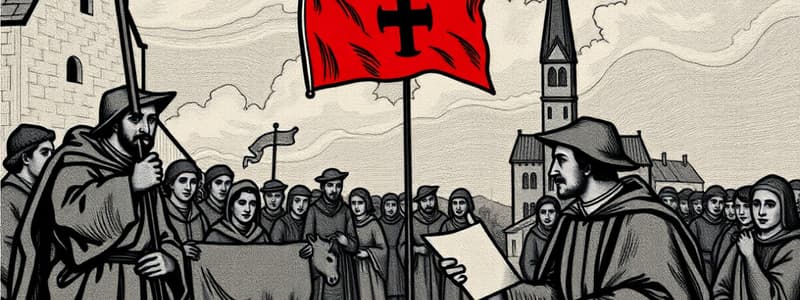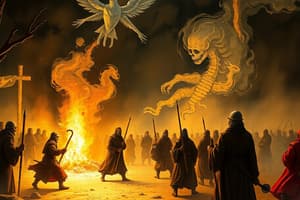Podcast
Questions and Answers
Feudalism in Germany was characterized by extreme labor, little reward, reduced freedom, and ______ punishments to the peasants.
Feudalism in Germany was characterized by extreme labor, little reward, reduced freedom, and ______ punishments to the peasants.
arbitrary
Some priests presented a list of grievances to Luther known as the '______ Articles'.
Some priests presented a list of grievances to Luther known as the '______ Articles'.
Twelve
Luther's response to the list of grievances included both acknowledgement and ______ of the cited practices.
Luther's response to the list of grievances included both acknowledgement and ______ of the cited practices.
rebuke
The nobles and peasants expressed ______ after Luther's initial response to their grievances, contributing to further unrest.
The nobles and peasants expressed ______ after Luther's initial response to their grievances, contributing to further unrest.
The Peasants' Revolt, marked by significant unrest in Germany, occurred between the years 1524 and ______.
The Peasants' Revolt, marked by significant unrest in Germany, occurred between the years 1524 and ______.
Luther's solution to the chaos of the Peasants' Revolt involved the proposal of ______ religion.
Luther's solution to the chaos of the Peasants' Revolt involved the proposal of ______ religion.
The '______ of Augsburg' in 1555 helped to bring a state of peace to Germany by acknowledging religious divisions.
The '______ of Augsburg' in 1555 helped to bring a state of peace to Germany by acknowledging religious divisions.
Luther emphasized that 'Christianity must not be thought of as a ______ political movement'.
Luther emphasized that 'Christianity must not be thought of as a ______ political movement'.
By 1600, there were at least seven State churches in Europe, including Anglican, Calvinist, Catholic, Dutch Reformed, Eastern Orthodox, Presbyterian, and ______.
By 1600, there were at least seven State churches in Europe, including Anglican, Calvinist, Catholic, Dutch Reformed, Eastern Orthodox, Presbyterian, and ______.
The ______ aimed to bring about certain restricted changes within the Roman Church, particularly in regards to morality.
The ______ aimed to bring about certain restricted changes within the Roman Church, particularly in regards to morality.
After reading about Roman saints and the life of Christ, ______ Loyola felt compelled to repent.
After reading about Roman saints and the life of Christ, ______ Loyola felt compelled to repent.
Ignatius Loyola felt that he could earn his salvation by ______ to the church of Rome and the Pope.
Ignatius Loyola felt that he could earn his salvation by ______ to the church of Rome and the Pope.
In 1540, Ignatius Loyola received approval to start an organization called the ______ of Jesus, or Jesuits.
In 1540, Ignatius Loyola received approval to start an organization called the ______ of Jesus, or Jesuits.
The Jesuits aimed to form a group of men dedicated to the Pope and the Roman Church and were seen as the '______ arm' for the Counter-Reformation.
The Jesuits aimed to form a group of men dedicated to the Pope and the Roman Church and were seen as the '______ arm' for the Counter-Reformation.
The Jesuit's motto, '______ justifies the means,' reflected their commitment to achieving the goals of the Church regardless of the methods employed.
The Jesuit's motto, '______ justifies the means,' reflected their commitment to achieving the goals of the Church regardless of the methods employed.
The Jesuits used ______ as a way to serve the Church by strengthening members and reclaiming Protestants.
The Jesuits used ______ as a way to serve the Church by strengthening members and reclaiming Protestants.
In 170 years, the Jesuits controlled 612 colleges, 24 universities, and 150 ______ schools.
In 170 years, the Jesuits controlled 612 colleges, 24 universities, and 150 ______ schools.
The Roman Church was convinced that it was the Kingdom of God on Earth and viewed the Protestant movement as a ______ to that kingdom.
The Roman Church was convinced that it was the Kingdom of God on Earth and viewed the Protestant movement as a ______ to that kingdom.
Protestants viewed the Pope as the ______ of the last day.
Protestants viewed the Pope as the ______ of the last day.
Negotiations began between the peasants and nobles after a small group of peasants refused to give in to the riots and ______.
Negotiations began between the peasants and nobles after a small group of peasants refused to give in to the riots and ______.
Flashcards
Feudalism in Germany
Feudalism in Germany
Extreme labor, little reward, reduced freedom, and arbitrary punishments imposed on peasants.
The "Twelve Articles"
The "Twelve Articles"
A list of grievances presented to Luther by some priests.
Luther's Response to Grievances
Luther's Response to Grievances
Luther rebuked the practices mentioned in the list but his response dissatisfied both nobles and peasants leading to rebellion.
Peasants' Revolt
Peasants' Revolt
Signup and view all the flashcards
Luther's Solution to Riot and Chaos
Luther's Solution to Riot and Chaos
Signup and view all the flashcards
The Peace of Augsburg (1555)
The Peace of Augsburg (1555)
Signup and view all the flashcards
Luther's View on Christianity
Luther's View on Christianity
Signup and view all the flashcards
Anglican State Church Location
Anglican State Church Location
Signup and view all the flashcards
Calvinist State Church Location
Calvinist State Church Location
Signup and view all the flashcards
Dutch Reformed State Church Location
Dutch Reformed State Church Location
Signup and view all the flashcards
Easter Orthodox State Church Location
Easter Orthodox State Church Location
Signup and view all the flashcards
Lutheran State Church Location
Lutheran State Church Location
Signup and view all the flashcards
The Counter-Reformation
The Counter-Reformation
Signup and view all the flashcards
Ignatius Loyola
Ignatius Loyola
Signup and view all the flashcards
Goal of the Jesuits
Goal of the Jesuits
Signup and view all the flashcards
Jesuits' Method of Service
Jesuits' Method of Service
Signup and view all the flashcards
"The end justifies the means"
"The end justifies the means"
Signup and view all the flashcards
How the Roman Church viewed the Protestants.
How the Roman Church viewed the Protestants.
Signup and view all the flashcards
How Protestants viewed the Pope.
How Protestants viewed the Pope.
Signup and view all the flashcards
Study Notes
- German feudalism involved extreme labor, little reward, reduced freedom, and arbitrary punishments for peasants.
- Some priests compiled a list of grievances called the “Twelve Articles” and presented them to Luther.
- Luther acknowledged and rebuked the practices outlined in the Twelve Articles.
- Nobles and peasants were unsatisfied with Luther's response to the Twelve Articles.
- This dissatisfaction led to the start of the Rebellion.
Peasants' Revolt
- The Peasants’ Revolt in Germany occurred between 1524 and 1525.
- A small group of peasants wanted negotiations instead of riots and violence.
Luther's Solution
- Luther proposed institutionalized religion to resolve the unrest.
- Churches were established according to region.
- The Peace of Augsburg in 1555 helped bring peace to Germany.
- Luther stated that Christianity should not be considered a revolutionary political movement.
State Churches in Europe by 1600
- By 1600, there were at least 7 state churches in Europe.
- These include Anglican (England-Ireland), Calvinist (France-Switzerland), Catholic, Dutch Reformed (Netherlands), Eastern Orthodox (Russia), Presbyterian, and Lutheran (Germany, Denmark, Sweden, Norway).
Counter-Reformation
- The Counter-Reformation aimed to bring limited moral changes within the Roman Church.
- Ignatius Loyola repented after reading Roman saints and the life of Christ.
- Loyola wanted to serve the Church of Rome and the Pope to earn salvation after confessing for 3 days.
- In 1540, Loyola received approval to start the Society of Jesus, or Jesuits.
- The Jesuit goal was to form a group of men dedicated to the Pope and the Roman Church.
- Jesuits were viewed as the “spiritual arm” for the Counter-Reformation.
- They believed "The end justifies the means".
- Jesuits used education to strengthen existing members and reclaim Protestants.
- In 170 years, they controlled 612 colleges, 24 universities, and 150 normal schools.
Religious Views
- The Roman Church believed itself to be to be the Kingdom of God on Earth.
- They viewed the Protestant movement as a threat to their kingdom.
- Protestants considered the Pope to be the Antichrist.
Studying That Suits You
Use AI to generate personalized quizzes and flashcards to suit your learning preferences.




